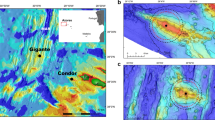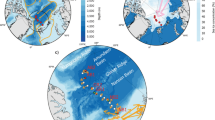Abstract
Movements of the scavenging deep-sea fish Coryphaenoides (Nematonurus) armatus were tracked at depths of 2500–4800 m on the Porcupine Abyssal Plain and Porcupine Seabight in the NE Atlantic using the Aberdeen University Deep Ocean Submersible (AUDOS). The AUDOS was deployed with mackerel bait and three coded acoustic transponders (CATs) covered in mackerel flesh and each enclosed in a nylon bag. Time lapse photographs allowed identification of fish ingesting CATs and estimation of fish arrival times and staying times at the bait. The radial swimming speeds recorded were much slower than inferred in previous studies using older designs of tracking equipment.
It was found that C.(N.) armatus moved away from the bait source at an average rate of 1.05 m min-1 and separated from one another at an average rate of 1.32 m min-1 indicating solitary independent movement with no evidence of shoaling aggregation. The average time delay before food falls were intercepted by C.(N.) armatus in the study area was 26 min, the mean fish staying time was 115 min and the swimming time required to disperse the bait to background organic carbon density in the benthos was 46 min. Thus total time for food-fall dispersal after arrival on the sea floor was approximately 3 h.
Similar content being viewed by others
References
Armstrong, J. D., P. M. Bagley & I. G. Priede, 1992a. Photographic and acoustic tracking observations of the behaviour of the grenadier, Coryphaenoides (Nematonurus) armatus, the eel, Synaphobranchus bathybius, and other abyssal demersal fish in the North Atlantic Ocean. Mar. Biol. 112: 535–544.
Armstrong, J. D., P. M. Bagley & I. G. Priede, 1992b. Tracking deep-sea fish using ingestible transmitters and an autonomous sea-floor instrument package. In I. G. Priede & S. M. Swift (eds), Wildlife Telemetry: Remote Monitoring and Tracking of Animals. Ellis Horwood. Chichester: 376–386.
Bagley, P. M., 1992. A code-activated transponder for the individual indentification and tracking of deep sea fish. In I. G. Priede & S. M. Swift (eds), Wildlife Telemetry: Remote Monitoring and Tracking of Animals. Ellis Horwood. Chichester: 111–119.
Bagley, P. M. & I. G. Priede, 1997. An autonomous free-fall acoustic tracking system for investigation of fish behaviour at abyssal depths. Aquat. Living Res. 10: 67–74.
Bagley, P. M., A. Smith & I. G. Priede, 1994. Tracking movements of deep demersal fishes, Coryphaenoides (Nematonurus) armatus, Antimora rostrata and Centroscymnus coelolepis in the Porcupine Seabight, N. E. Atlantic Ocean. J. Mar. Biol. Assoc. U. K. 74: 473–480.
Hinga, K. R. J., J. McN. Sieberth & G. R. Heath, 1979. The supply and use of organic material at the deep-sea floor. J. mar. Res. 37: 557–579.
Isaacs, J. D. & R. A. Schwartzlose, 1975. Active animals of the deep-sea floor. Sci. Am. 233: 85–91.
Jones, E. G., M. A. Collins, P. M. Bagley, S. Addison & I. G. Priede, 1998. The tate of cetacean carcasses in the deep sea: observations on consumption rates and succession of scavenging species in the abyssal north-east Atlantic Ocean. Proceedings of the Royal Society, London B, 265: 1–9.
Lampitt, R. S., 1985. Evidence for the seasonal deposition of detritus to the deep-sea floor and its subsequent resuspension. Deep Sea Res. 32: 885–897.
Lampitt, R. S., R. T. C. Raine, D. S. M. Billett & A. L. Rice, 1995. Material supply to the European continental slope: a budget based on benthc oxygen demand and organic supply. Deep Sea Res. 42: 1865–1880.
Mackenzie, K. V., 1981. Nine-term equations for sound speed in the oceans. J. acoust. Soc. Am. 70: 807–812.
Priede, I. G., P. M. Bagley, S. Addison, S. Bradley & M. A. Collins, 1996. New Methods for Tracking Deep Sea Fishes. Proceedings of the 5th European Conference of Wildlife Telemetry. Strasbourg.
Priede, I. G., P. Bagley, J. D. Armstrong, K. L. Smith & N. R. Merrett, 1991. Direct Measurement of Active dispersal of Food-falls by abyssal demersal fishes. Nature 351: 647–649.
Priede, I. G., P. M. Bagley, A. Smith, S. Creasey & N. R. Merrett, 1994a. Scavenging deep demersal fishes of the Porcupine Seabight, (NE Atlantic Ocean); observations by baited camera, trap and trawl. J. Mar. Biol. Assoc. U. K. 74: 481–498.
Priede, I. G., P. M. Bagley & K. L. Smith Jr., 1994b. Seasonal change in activity of abyssal demersal scavenging grenadiers Coryphaenoides (Nematonurus) armatus in the eastern North Pacific Ocean. Limnol. Oceanogr. 39: 279–285.
Priede, I. G. & K. L. Smith Jr., 1986. Behaviour of the abyssal grenadier, Coryphaenoides yaquinae, monitored using ingestible acoustic transmitters in the Pacific Ocean. J. Fish Biol. 29 (Suppl. A): 199–206.
Priede, I. G., K. L. Smith Jr. & J. D. Armstrong, 1990. Foraging behaviour of abyssal grenadier fish: inferences from acoustic tagging and tracking in the North Pacific Ocean. Deep-sea Res. 37: 81–101.
Smith, A., I. G. Priede, P. M. Bagley & S. W. Addison, 1997. Interception and dispersal of artificial food falls by scavenging fishes in the abyssal NE Atlantic: early season observations prior to annual deposition of phytodetritus. Mar. Biol. 128: 329–336.
Stockton, W. L. & T. E. DeLaca, 1982. Food falls in the deep-sea: occurrence, quality and significance. Deep-Sea Res. 29: 157–169.
Rights and permissions
About this article
Cite this article
Collins, M.A., Priede, I.G., Addison, S. et al. Acoustic tracking of the dispersal of organic matter by scavenging fishes in the deep-sea. Hydrobiologia 371, 181–186 (1998). https://doi.org/10.1023/A:1017083107914
Issue Date:
DOI: https://doi.org/10.1023/A:1017083107914




